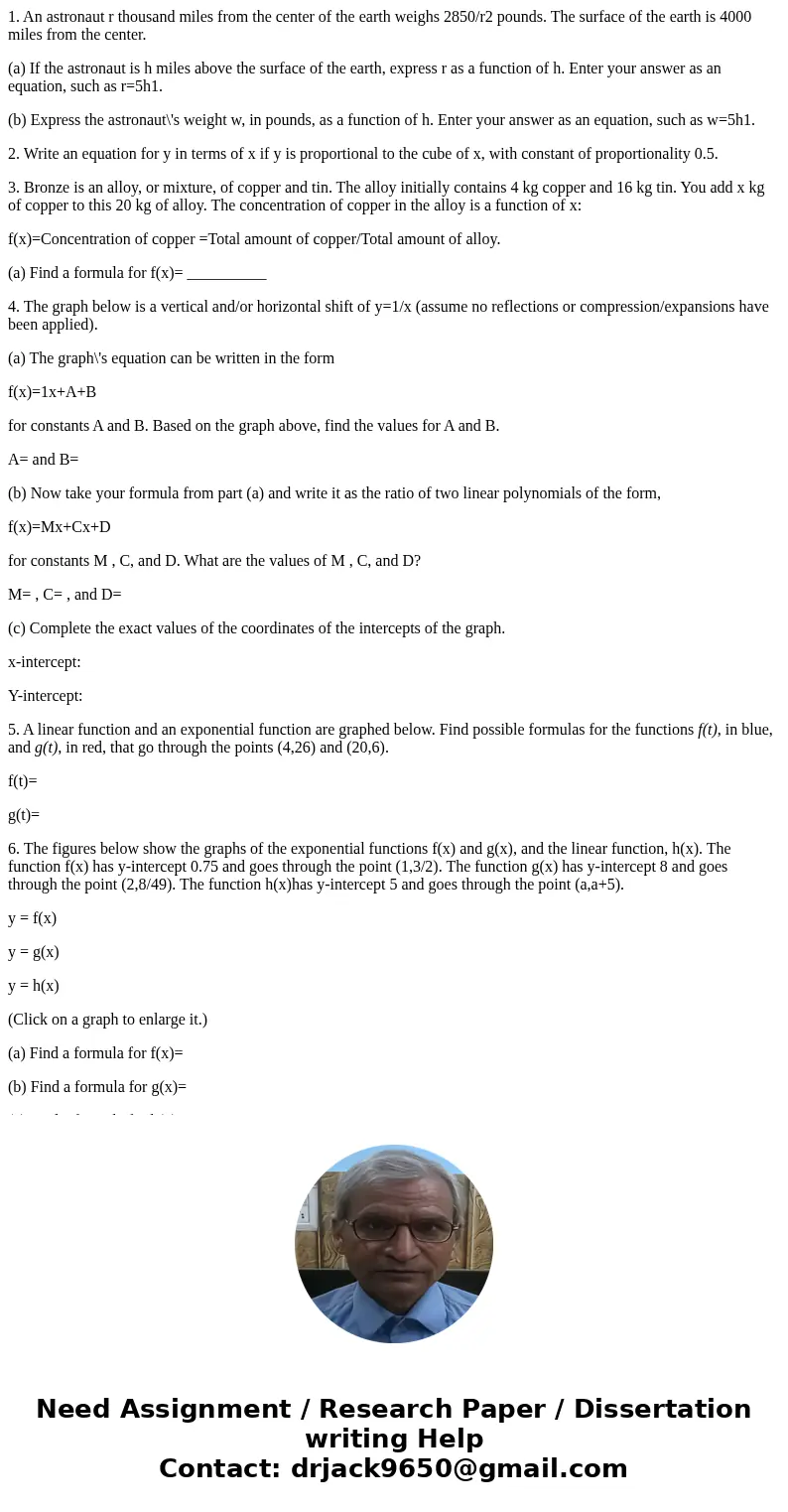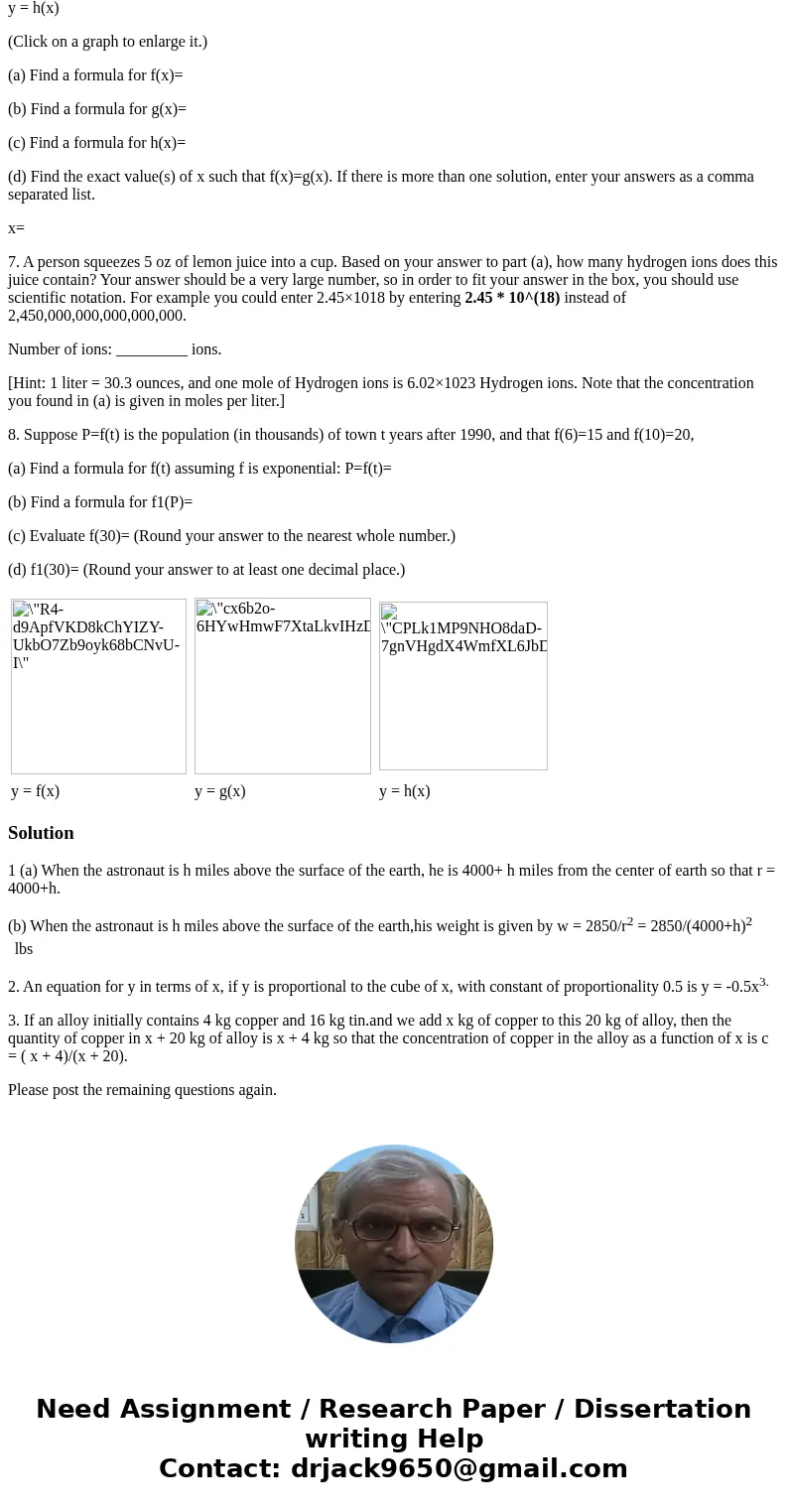1 An astronaut r thousand miles from the center of the earth
1. An astronaut r thousand miles from the center of the earth weighs 2850/r2 pounds. The surface of the earth is 4000 miles from the center.
(a) If the astronaut is h miles above the surface of the earth, express r as a function of h. Enter your answer as an equation, such as r=5h1.
(b) Express the astronaut\'s weight w, in pounds, as a function of h. Enter your answer as an equation, such as w=5h1.
2. Write an equation for y in terms of x if y is proportional to the cube of x, with constant of proportionality 0.5.
3. Bronze is an alloy, or mixture, of copper and tin. The alloy initially contains 4 kg copper and 16 kg tin. You add x kg of copper to this 20 kg of alloy. The concentration of copper in the alloy is a function of x:
f(x)=Concentration of copper =Total amount of copper/Total amount of alloy.
(a) Find a formula for f(x)= __________
4. The graph below is a vertical and/or horizontal shift of y=1/x (assume no reflections or compression/expansions have been applied).
(a) The graph\'s equation can be written in the form
f(x)=1x+A+B
for constants A and B. Based on the graph above, find the values for A and B.
A= and B=
(b) Now take your formula from part (a) and write it as the ratio of two linear polynomials of the form,
f(x)=Mx+Cx+D
for constants M , C, and D. What are the values of M , C, and D?
M= , C= , and D=
(c) Complete the exact values of the coordinates of the intercepts of the graph.
x-intercept:
Y-intercept:
5. A linear function and an exponential function are graphed below. Find possible formulas for the functions f(t), in blue, and g(t), in red, that go through the points (4,26) and (20,6).
f(t)=
g(t)=
6. The figures below show the graphs of the exponential functions f(x) and g(x), and the linear function, h(x). The function f(x) has y-intercept 0.75 and goes through the point (1,3/2). The function g(x) has y-intercept 8 and goes through the point (2,8/49). The function h(x)has y-intercept 5 and goes through the point (a,a+5).
y = f(x)
y = g(x)
y = h(x)
(Click on a graph to enlarge it.)
(a) Find a formula for f(x)=
(b) Find a formula for g(x)=
(c) Find a formula for h(x)=
(d) Find the exact value(s) of x such that f(x)=g(x). If there is more than one solution, enter your answers as a comma separated list.
x=
7. A person squeezes 5 oz of lemon juice into a cup. Based on your answer to part (a), how many hydrogen ions does this juice contain? Your answer should be a very large number, so in order to fit your answer in the box, you should use scientific notation. For example you could enter 2.45×1018 by entering 2.45 * 10^(18) instead of 2,450,000,000,000,000,000.
Number of ions: _________ ions.
[Hint: 1 liter = 30.3 ounces, and one mole of Hydrogen ions is 6.02×1023 Hydrogen ions. Note that the concentration you found in (a) is given in moles per liter.]
8. Suppose P=f(t) is the population (in thousands) of town t years after 1990, and that f(6)=15 and f(10)=20,
(a) Find a formula for f(t) assuming f is exponential: P=f(t)=
(b) Find a formula for f1(P)=
(c) Evaluate f(30)= (Round your answer to the nearest whole number.)
(d) f1(30)= (Round your answer to at least one decimal place.)
| | | | ||
| y = f(x) | y = g(x) | y = h(x) |
Solution
1 (a) When the astronaut is h miles above the surface of the earth, he is 4000+ h miles from the center of earth so that r = 4000+h.
(b) When the astronaut is h miles above the surface of the earth,his weight is given by w = 2850/r2 = 2850/(4000+h)2 lbs
2. An equation for y in terms of x, if y is proportional to the cube of x, with constant of proportionality 0.5 is y = -0.5x3.
3. If an alloy initially contains 4 kg copper and 16 kg tin.and we add x kg of copper to this 20 kg of alloy, then the quantity of copper in x + 20 kg of alloy is x + 4 kg so that the concentration of copper in the alloy as a function of x is c = ( x + 4)/(x + 20).
Please post the remaining questions again.


 Homework Sourse
Homework Sourse